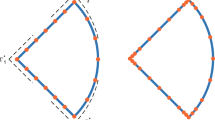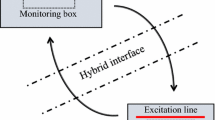Abstract
Fast and high-order accurate algorithms for three-dimensional elastic scattering are of great importance when modeling physical phenomena in mechanics, seismic imaging, and many other fields of applied science. In this paper, we develop a novel boundary integral formulation for the three-dimensional elastic scattering based on the Helmholtz decomposition of elastic fields, which converts the Navier equation to a coupled system consisted of Helmholtz and Maxwell equations. An FFT-accelerated separation of variables solver is proposed to efficiently invert boundary integral formulations of the coupled system for elastic scattering from axisymmetric rigid bodies. In particular, by combining the regularization properties of the singular boundary integral operators and the FFT-based fast evaluation of modal Green’s functions, our numerical solver can rapidly solve the resulting integral equations with a high-order accuracy. Several numerical examples are provided to demonstrate the efficiency and accuracy of the proposed algorithm, including geometries with corners at different wavenumbers.
Similar content being viewed by others
References
Ahner, J.F., Hsiao, G.C.: On the two-dimensional exterior boundary-value problems of elasticity. SIAM J. Appl. Math. 31, 677–685 (1976)
Albella Martínez, J., Imperiale, S., Joly, P., Rodríguez, J.: Solving 2D linear isotropic elastodynamics by means of scalar potentials: a new challenge for finite elements. J. Sci. Comput. 77, 1832–1873 (2018)
Alpert, B.: Hybrid Gauss-trapezoidal quadrature rules. SIAM J. Sci. Comput. 20(5), 1551–1584 (1999)
Ammari, H., Bretin, E., Garnier, J., Kang, H., Lee, H., Wahab, A.: Mathematical Methods in Elasticity Imaging. Princeton University Press, New Jersey (2015)
Bao, G., Xu, L., Yin, T.: An accurate boundary element method for the exterior elastic scattering problem in two dimensions. J. Comput. Phys. 348, 343–363 (2017)
Borges, C., Lai, J.: Inverse scattering reconstruction of a three dimensional sound-soft axis-symmetric impenetrable object. Inverse Prob. 36(10), 105005 (2020)
Bremer, J.: On the Nyström discretization of integral equations on planar curves with corners. Appl. Comput. Harm. Anal. 32, 45–64 (2012)
Bremer, J., Gimbutas, Z.: A Nyström method for weakly singular integral operators on surfaces. J. Comput. Phys. 231(14), 4885–4903 (2012)
Bremer, J., Gimbutas, Z., Rokhlin, V.: A nonlinear optimization procedure for generalized Gaussian quadratures. SIAM J. Sci. Comput. 32(4), 1761–1788 (2010)
Bruno, O.P., Yin, T.: Regularized integral equation methods for elastic scatteringproblems in three dimensions. J. Comput. Phys. 410, 109350 (2020)
Bu, F., Lin, J., Reitich, F.: A fast and high-order method for the three-dimensional elastic wave scattering problem. J. Comput. Phys. 258, 856–870 (2014)
Cohl, H.S., Tohline, J.E.: A compact cylindrical Green’s function expansion for the solution of potential problems. Astrophys. J. 527(1), 86–101 (1999)
Conway, J.T., Cohl, H.S.: Exact Fourier expansion in cylindrical coordinates for the three-dimensional Helmholtz Green function. Z. Angew. Math. Phys. 61, 425–442 (2010)
Colton, D., Kress, R.: Inverse Acoustic and Electromagnetic Scattering Theory, 3rd edn. Springer, New York (2013)
Dong, H., Lai, J., Li, P.: Inverse obstacle scattering for elastic waves with phased or phaseless far-field data. SIAM J. Imaging Sci. 12, 809–838 (2019)
Dong, H., Lai, J., Li, P.: An inverse acoustic-elastic interaction problem with phased or phaseless far-field data. Inverse Probl. 36, 035014 (2020)
Dong, H., Lai, J., Li, P.: A highly accurate boundary integral method for the elastic obstacle scattering problem. Math. Comput. 90, 2785–2814 (2021)
Epstein, C.L., Greengard, L., O’Neil, M.: A high-order wideband direct solver for electromagnetic scattering from bodies of revolution. J. Comput. Phys. 387, 205–229 (2019)
Felipe, V., Leslie, G., Zydrunas, G.: Boundary integral equation analysis on the sphere. Numer. Math. 128, 463–487 (2014)
Geng, N., Carin, L.: Wide-band electromagnetic scattering from a dielectric BOR buried in a layered lossy dispersive medium. IEEE Trans. Antennas Propag. 47(4), 610–619 (1999)
Gillman, A., Young, P.M., Martinsson, P.G.: A direct solver with O(N) complexity for integral equations on one-dimensional domains. Front. Math. China 7(2), 217–247 (2012)
Gimbutas, Z., Greengard, L.: Fast multi-particle scattering: a hybrid solver for the Maxwell equations in microstructured materials. J. Comput. Phys. 232, 22–32 (2013)
Greengard, L., Rokhlin, V.: A fast algorithm for particle simulations. J. Comput. Phys. 73, 325–348 (1987)
Greengard, L., O’Neil, M., Rachh, M., Vico, F.: Fast multipole methods for evaluation of layer potentials with locally-corrected quadratures. Submitted. arXiv:2006.02545
Gustafsson, M.: Accurate and efficient evaluation of modal green’s functions. J. Electromagnet. Wave. 24(10), 1291–1301 (2010)
Hao, S., Barnett, A.H., Martinsson, P.G., Young, P.: High-order accurate Nyström discretization of integral equations with weakly singular kernels on smooth curves in the plane. Adv. Comput. Math. 40, 245–272 (2014)
Hao, S., Martinsson, P.G., Young, P.: An efficient and highly accurate solver for multi-body acoustic scattering problems involving rotationally symmetric scatterers. Comput. Math. Appl. 69, 304–318 (2015)
Helsing, J., Holst, A.: Variants of an explicit kernel-split panel-based Nyström discretization scheme for Helmholtz boundary value problems. Adv. Comput. Math. 41, 691–708 (2015)
Helsing, J., Karlsson, A.: An explicit kernel-split panel-based Nyström scheme for integral equations on axially symmetric surfaces. J. Comput. Phys. 272, 686–703 (2014)
Helsing, J., Karlsson, A.: Determination of normalized electric eigenfields in microwave cavities with sharp edges. J. Comput. Phys. 304(Supplement C), 465–486 (2016)
Helsing, J., Karlsson, A.: Resonances in axially symmetric dielectric objects. IEEE Trans. Microw. Theory Tech. 65(7), 2214–2227 (2017)
Helsing, J., Ojala, R.: Corner singularities for elliptic problems: integral equations, graded meshes, quadrature, and compressed inverse preconditioning. J. Comput. Phys. 227, 8820–8840 (2008)
Ho, K.L., Greengard, L.: A fast direct solver for structured linear systems by recursive skeletonization. SIAM J. Sci. Comput. 34(5), 2507–2532 (2012)
Hu, G., Kirsch, A., Sini, M.: Some inverse problems arising from elastic scattering by rigid obstacles. Inverse Probl. 29, 015009 (2013)
Kolm, P., Jiang, S., Rokhlin, V.: Quadruple and octuple layer potentials in two dimensions I: analytical apparatus. Appl. Comput. Harmon. Anal. 14, 47–74 (2003)
Kress, R.: Linear Integral Equations. Springer, New York (1999)
Lai, J., Li, P.: A framework for simulation of multiple elastic scattering in two dimensions. SIAM J. Sci. Comput. 41, A3276–A3299 (2019)
Lai, J., O’Neil, M.: An FFT-accelerated direct solver for electromagnetic scattering from penetrable axisymmetric objects. J. Comput. Phys. 390, 152–174 (2019)
Lai, J., Ambikasaran, S., Greengard, L.F.: A fast direct solver for high frequency scattering from a large cavity in two dimensions. SIAM J. Sci. Comput. 36(6), B887–B903 (2014)
Lai, J., Greengard, L., O’Neil, M.: Robust integral formulations for electromagnetic scattering from three-dimensional cavities. J. Comput. Phys. 345, 1–16 (2017)
Liu, Y., Barnett, A. H.: Efficient numerical solution of acoustic scattering from doubly-periodic arrays of axisymmetric objects. J. Comput. Phys. 324, 226–245 (2016)
Louër, F.L.: On the fréchet derivative in elastic obstacle scattering. SIAM J. Appl. Math. 72, 1493–1507 (2012)
Louër, F.L.: A high order spectral algorithm for elastic obstacle scattering in three dimensions. J. Comput. Phys. 279, 1–17 (2014)
O’Neil, M., Cerfon, A.J.: An integral equation-based numerical solver for Taylor states in toroidal geometries. J. Comput. Phys. 359, 263–282 (2018)
Pao, Y.H., Varatharajulu, V.: Huygens’ principle, radiation conditions, and integral formulas for the scattering of elastic waves. J. Acoust. Soc. Am. 59, 1361–1371 (1976)
Tong, M.S., Chew, W.C.: Nyström method for elastic wave scattering by three-dimensional obstacles. J. Comput. Phys. 226, 1845–1858 (2007)
Young, P., Hao, S., Martinsson, P.G.: A high-order Nyström discretization scheme for boundary integral equations defined on rotationally symmetric surfaces. J. Comput. Phys. 231(11), 4142–4159 (2012)
Yu, W.M., Fang, D.G., Cui, T.J.: Closed form modal green’s functions for accelerated computation of bodies of revolution. IEEE Trans. Antennas Propag. 56(11), 3452–3461 (2008)
Funding
The work of JL was partially supported by the Funds for Creative Research Groups of NSFC (No. 11621101), NSFC Grant No. U21A20425 and NSFC Grant No. 11871427. The work of HD was partially supported by NSFC Grant No. 12171201 and the National Key Research and Development Program of China (Grant No. 2020YFA0713602).
Author information
Authors and Affiliations
Corresponding author
Ethics declarations
Competing interests
The authors declare no competing interests.
Additional information
Communicated by: Gunnar J Martinsson
Publisher’s note
Springer Nature remains neutral with regard to jurisdictional claims in published maps and institutional affiliations.
This article belongs to the Topical Collection: Advances in Computational Integral Equations
Guest Editors: Stephanie Chaillat, Adrianna Gillman, Per-Gunnar Martinsson, Michael O’Neil, Mary-Catherine Kropinski, Timo Betcke, Alex Barnett
Appendix.: Fourier expansion for the surface gradient and divergence
Appendix.: Fourier expansion for the surface gradient and divergence
Let Γ be the boundary of a three-dimensional axisymmetric object with parametrization given by
and (τ1,τ2) be the unit orthogonal tangential vectors on Γ. Here we do not require the parameter s to be the arclength of the generating curve of Γ.
Lemma 1
The surface gradient of a function σ ∈ C1,α(Γ) with Fourier expansion (??) is given by
The surface divergence of a tangential vector \(\boldsymbol {J}=J^{1}\boldsymbol {\tau }_1+J^{2}\boldsymbol {\tau }_2\in T_{d}^{0,\alpha }({\varGamma })\) with Fourier expansion (??) is given by
We first show the expression of Grady(n(x) ⋅n(y)) and Divy(n(y) ×τi(x) ×n(y)), i = 1, 2 in the parametrization form. Since
where \(C_{s} = 1/\sqrt {r^{\prime }(s)^{2}+z^{\prime }(s)^{2}}\), \( C_{t} = 1/\sqrt {r^{\prime }(t)^{2}+z^{\prime }(t)^{2}}\), it holds
Similarly, since
by Lemma 7, it holds
and
To numerically construct the surface gradient operator for an unknown function σ, we make use of the fact that σ is discretized on p scaled Gauss-Legendre nodes on each panel as discussed in Section ??. Following the notation in Section ??, σ on the i th panel γi is approximated by
Therefore the surface divergence can be approximated as
By taking y to be the p scaled Gauss-Legendre nodes on the i th panel, we obtain the discretized surface gradient operator for σ. The discretization of surface divergence operator for a tangential vector function J can be constructed similarly.
Combining the results above with Lemmas 3 and 4, we are able to obtain the azimuthal Fourier decomposition of boundary operators \({\mathscr{H}}\) and \(\mathcal {N}\).
Rights and permissions
About this article
Cite this article
Lai, J., Dong, H. A fast solver for elastic scattering from axisymmetric objects by boundary integral equations. Adv Comput Math 48, 20 (2022). https://doi.org/10.1007/s10444-022-09935-5
Received:
Accepted:
Published:
DOI: https://doi.org/10.1007/s10444-022-09935-5
Keywords
- Elastic wave scattering
- Boundary integral equations
- Nyström method
- Helmholtz decomposition
- Navier equations




